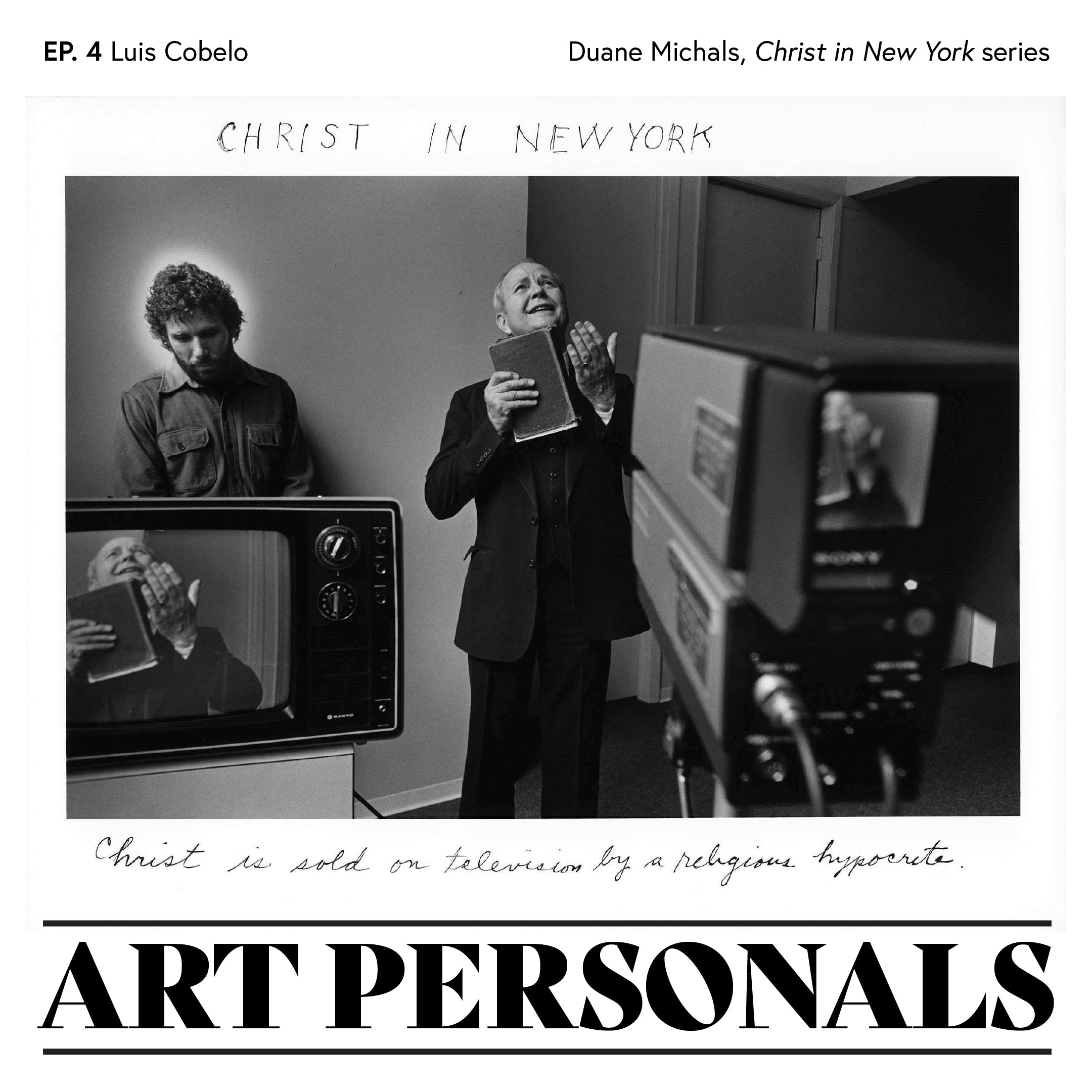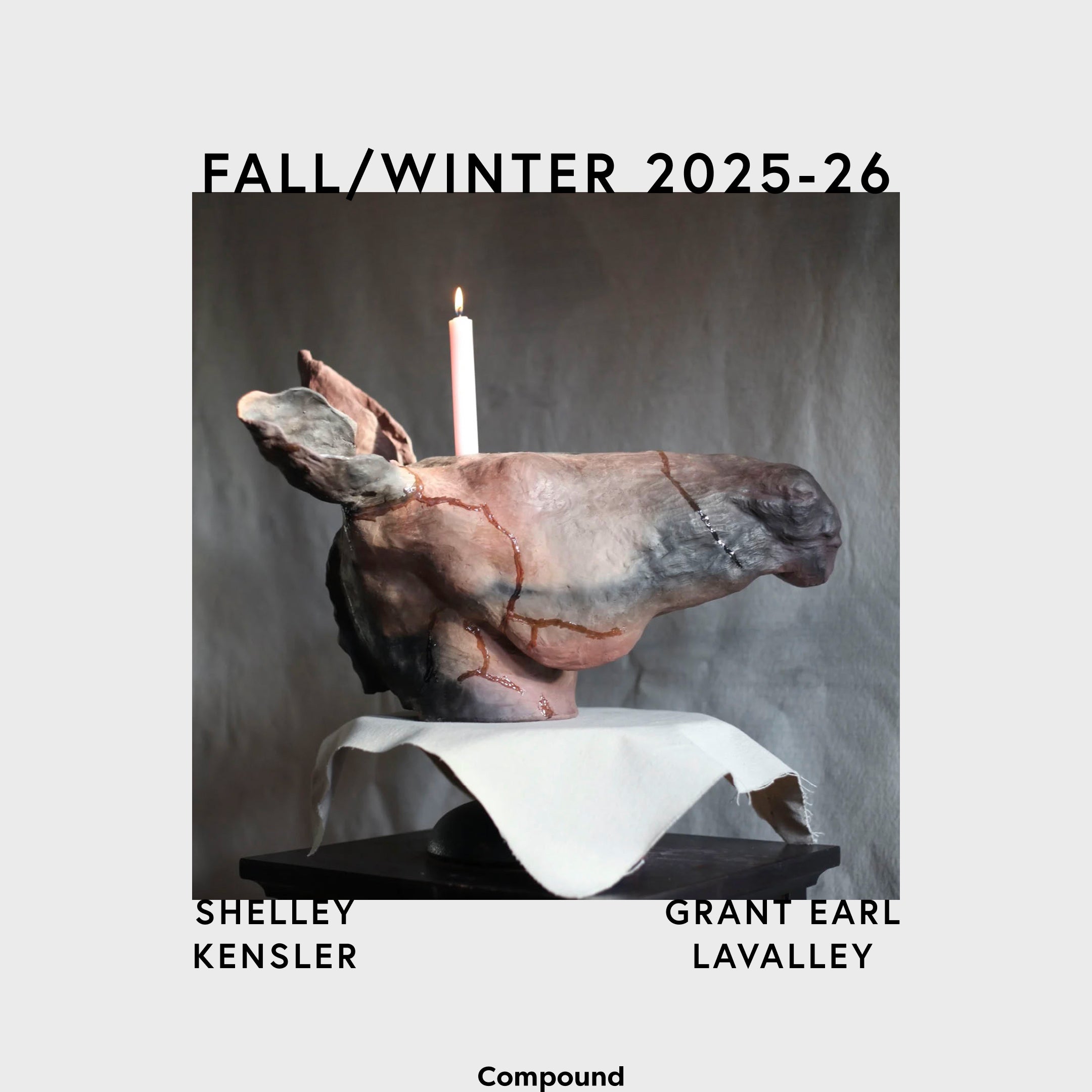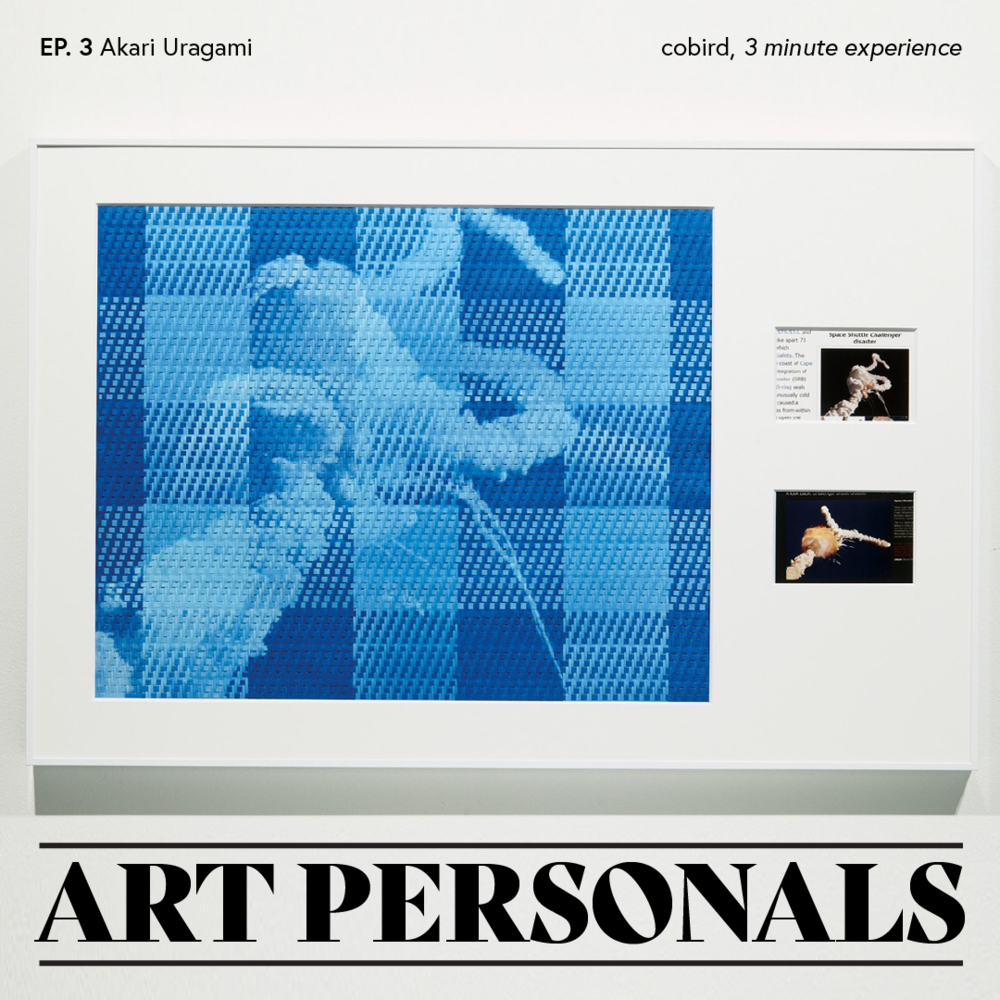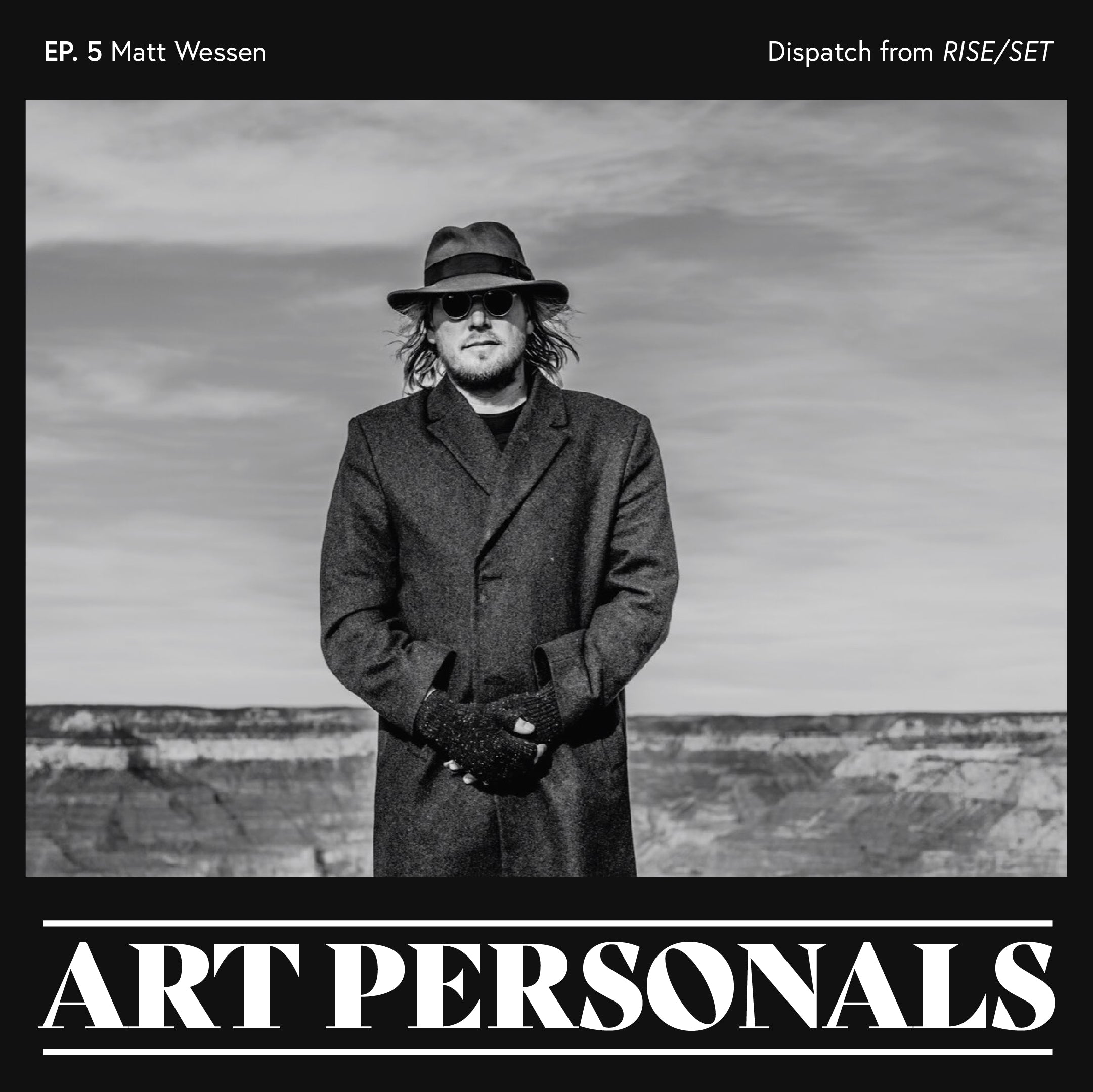
Luis Cobelo Describes Duane Michals
Luis Cobelo (b. 1970, Venezuela) holds a degree in Philosophy from the University of Zulia in Venezuela. He was raised between Venezuela and Spain, where he became a photographer. Beginning in 1993, he participated in numerous international photography festivals and solo exhibitions. Working independently across borders since 2001, Luis has developed documentary projects in the Americas, Asia and Europe, and has been published in magazines and newspapers worldwide. He is based in San Francisco, California.
The photographs he describes in this episode are:


Duane Michael (American, 1932)
Christ in New York
Christ is sold on television by a religious hypocrite
Christ is shot by a mugger with a hand gun and dies
Circa 1981–1984
Gelatin Silver Print
each sheet: 8”x 0”; each image: 5” x 7”
Episode Transcript
Welcome to Art Personals, a podcast made by Compound Yucca Valley, an art and event space in California’s high desert. Here, we ask some of our favorite artists to describe another artist’s work as best they can, with only their words and sounds. The one parameter is that the object they choose must be one they have seen in person at some point in their lives (whether that's an ancient artwork in the Metropolitan Museum of Art or a friend's painting in a garage).
Today, we’ve invited Luis Cobelo, who has chosen to share his experience with the photographer Duane Michals. He first encountered Michals in a Venezuelan photography journal, and later met the artist in Spain at the conference, Photoespaña. Luis describes two works that stood out to him from the series, “Christ in New York.” The captions handwritten on the gelatin silver prints say, “Christ is shot by a mugger with a hand gun and dies,” on the first and “Christ is sold on television by a religious hypocrite” on the second. Born in 1970, Luis Cobelo was raised between Venezuela and Spain where he became a photographer. Working independently across borders since 2001, Luis has developed documentary projects in the Americas, Asia and Europe, and has been published in many magazines and newspapers worldwide. Luis currently lives in San Francisco. His show, Chas Chas, opens at Compound YV on Oct. 16, 2021.
***
I always say that my influences don't have to do with just photographic images. They are beyond the simple images, which can be photographic, pictorial, musical, cinematographic, and graphic. And above all, certain artists, their attitude, what they think, where they belong, where they grow up and how; well, I realized that the artists who swim against the current are the ones that interest me the most.
My interest in photography brought me closer to the classics that are necessary to observe and study. I went through those that reflect reality, and went through those that go beyond the static images. I like this more, obviously. I had so many doubts because when I was starting at 17 years old, I was wondering how to create with a device that is not your head.
I mean, you need to know how to handle a technique to reflect what is in front of your eyes. Of a moment that has passed and that was real. This was with me for many years. So before finding the answer, I took another way, and I fell into the maelstrom of publications in magazines and newspapers because I had to demonstrate something that society dictated to me and to do things for others. I was working in a straight line, but I was lost. I was missing something. I was capturing too many fleeting moments, too few permanent, permanent things. It's not that I didn't feel good doing what I was doing. Just that it wasn't 100% of me only a little part.
And I realized that when I started taking photos, as I said before, around 17 years old, I always wanted to reflect what reality was, but transformed, not manually modified. At that time, it was manual. Not like now that there are millions of ways to digitally manipulate an image. With all the experiences that I accumulated, in my current age, I finally call myself an artist.
And with that look back, countless inspirations arose that were stored in my mind. This is how I remember the first impression I had when I saw the work of Duane Michals. Which for now, I will call what I think it should be called because in Spain or in Venezuela in Spanish, it was pronounced Dwan, Michelles.
I was in Venezuela browsing a photography magazine, and they had an article dedicated to Duane Michals. There were several series of his work, but the one "Jesus Christ" in particular left me thinking much more.
The first thing that blew my mind was seeing that he wrote in the photos. He took them to another level and his handwriting was already a work of art in its own. It didn't need to be perfect, just to be. It gave the images another possibility, expanding them to worlds that I didn't know existed, poetically, literally. That is what makes art, of course.
In addition to manipulating the image, Duane Michals show us Jesus as a symbol of purity, sacrifice and innocence. Duane Michals was creating a language and an idea in addition to laying a foundation that his thinking was criticizing the idea of Jesus and religion. He was questioning his existence and was fiercely criticizing the hypocrisy in which society interprets the figure of Jesus in the world.
With a few scrawled words, he reeled with irony and dark humor the hypocritical heart of society that lives by pretending to be what it is not. He turns this into an invisible guardian angel, the one we all want to have by our side. It is Duane Michals through Jesus who gives him the humanization that Jesus, as we have been told, really is good saviour and protector who sacrificed himself for your wellbeing and empathize with your pain of your drama.
The sense that Christ is ignored, denigrated and even trapped in everyday life situation is reinforced by the elements of the composition of each photograph. For example, in "Christ is Sold on Television by Religious Hypocrite", only the upper part of Christ's body is shown cut and inside the TV, among three images of the evangelist who is shown is standing next to Christ in the television screen and the video cameras screen. Christ has a gesture as if to say "this man does not know what he is saying, all are lies, what a shame."
Throughout the entire series, the figure of Christ is trapped in every day situations, and the most shocking thing is when he lies alone in an alley in "Christ Is Shot by a [Mugger with a Hand Gun] and Dies."
This is what Duane Michals tells us: that Christ came into the world and all these preachers keep crying out, and they kill him. Duane Michals assures me and millions that Christ could not survive in this world or in this society.
One of the incredible things is that this series is still valid. Nothing has changed since the time mid eighties until now. There is no doubt that there are old and new hypocrisies reinforced everyday. Isn't it extraordinary? Hmm.
This marked me a lot, which is the true revolution in a work.
Of course I was just starting out in photography. I couldn't believe that someone was doing that because I couldn't imagine it. It was not about manipulating photography to make something real, but about manipulating reality before/after taking a photo. There are several steps, the idea, producing the photo, taking it, developing it and finalizing the concept. Steps, which are in themselves like painting a picture, something that comes directly from your head. I repeat that does not need a machine, not to be a spectator of what is in front of us. You can do a lot with a pencil, and a few words. This is what creating a language is all about.
Years later, I had the opportunity to meet Mr. Michals personally in Spain, in Madrid. At that time I was working as a volunteer for Photoespaña, the most important photography festival in the country, and Mr. Michals was a star guest. Their organization asked me to assist him during the master class that he was giving. I said yes, without thinking, obviously. They told me that I had to translate some things in the conference. At that time, my English was not as good as it is now, which is still not perfect at all.
Mr. Michals is a wonderful human being. Far from being unsympathetic or impatient with my English, he was quite patient and with his dark humor and sarcastic, he handled it in his own way. And I want to believe that he enjoyed. It went well. He was very kind and generous to everyone.
The conference was for photographers and lovers of photography who had paid to be there. His way of working fascinated me from the first moment. I was definitely like him at the time, but I didn't know it yet. In different cultures and ages, but we definitely think the same.
At the end of the class, he offered to see some of the, of the attendees' work. He asked me if I had anything to show him. I say, no, (inside my head it would not have occurred to me to show him my work, at that moment I had nothing solid). A few risky and very optimistic photographers began to show their portfolios. I remember one especially, of a guy who at that time had a fairly successful solid job in the Spanish photography circuit.
I thought he would show Duane Michals what I had seen out there. But instead of that, his portfolio was about photographs taken in India.
The photographs were common places already seen in India. The photographer was expectant of Duane Michal's opinion. So he closed the last page of the portfolio, and he told him, "it looks like the look of a tourist and not that of an image creator. It's not bad to travel and take photos of what you see in front of your eyes. But here in this photo, the camera is alone. It doesn't have the person behind. It's letting itself be carried away by the surface. It goes no further. Art is something else. To end by saying the photos of your trip to India are very beautiful." I understood everything. It took me more years to apply it into my life as a photographer, artist or human being. During the last years I created the expression of taking pictures without knowing what you do as the "tourist bus syndrome," obviously inspired at that time by Duane Michals.
I kept trying, creating, I went through writing, painting, manipulating photos, painting in the edge, scratching them, breaking them. But the first step, that was the idea. And the concept before the photo was not clear, I was working from a base that does not match the following steps.
I skipped the pre- for the moment, which is to see something in front of your eyes transform it into the reality that is in your head without manipulating anything digitally or manually. Even if it's something spontaneous that cross your eyes or something that you stays on purpose. Just naming is enough. It reminds me a passage from the book "One Hundred Years of Solitude." One of my favorite, "The world was so recent that many things had no names, and to name them, you had to point your finger at them."
Well, some years ago I got it. Fortunately.
I think that the reality where we are is just a waiting room to enter the other realities that we can create. Thanks to Mr. Michals and other artists who influenced me day by day, I continue to fish in my memories for all those ideas that were inspired by books, news, movies, stories from my neighbor, the city where I was born, or the culture of my country, the culture of your country, paintings of the Renaissance of the middle age ....it's infinite, too many things.
And now, as long as I have vital time on this planet, I feel a freedom to make them according to what interests me the most, which can be anything. Isn't it fantastic?
***
Thanks for listening to Art Personals, a podcast produced by Compound Yucca Valley. You have been listening to Luis Cobelo discuss his encounter with Duane Michals' Christ in New York. If you enjoyed today’s episode, please consider supporting this artist whose prints you can now find over on our website at compoundyv.com.
You can learn more about Compound YV and stay tuned for future episodes over at our website and our instagram @compoundyv.
Art Personals is produced by Caroline Partamian, Lara Wilson, and Michael Townsend in collaboration with our artists.
Our interns are is Emiliano Vazquez.
Original music by Ethan Primason.
We curate shows for our virtual and physical spaces. If you are an artist interested in working with us, please send an email to hello@compoundyv.com.




